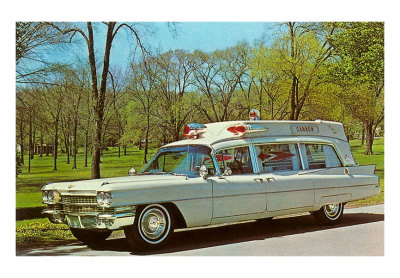One of the most common topics of debate in this business is something that should be simple. When is it okay for a patient to refuse transport to the hospital?
On the face of it this is a strange dilemma. When is it “okay”? What does that even mean? When is it okay to have Milano cookies and a bottle of Scotch for dinner? I don’t know. Leave me alone.
The chain of reasoning goes something like this. People call 911 because they have problems, and they don’t know how bad those problems are. By and large, we — the EMTs and paramedics on the ambulance — don’t know either. We don’t have the training or the tools to truly rule out major problems. So the only safe thing is to take the patient to the hospital. There, tall men with white coats, eight years of medical training, large expensive machines, and extensive liability insurance can decide if the patient is dying or not.
Okay. In some ways, that makes sense.
In other ways, it’s absurd. We all experience symptoms or incur injuries from time to time, and for the most part, we do not feel the need to visit the hospital to rule out deadly causes. Although it’s always a remote possibility that something is horribly wrong, in most cases it’s extremely unlikely, and it’s senseless to make an emergency out of every ache or sniffle. As we recently discussed, although it is possible to be very sick without looking like it, it is uncommon. If I woke up today with a minor headache, I wouldn’t want to spend hours of my time and hundreds of dollars at the emergency room “just in case.” So why does that suddenly become a reasonable course of action just because an EMS crew is standing in front of me?
There’s one good answer to this, which is that normally, I wouldn’t call 911 for a headache. So if there’s an ambulance here, it already means that for some reason, I had some special concern about this episode. Perhaps it was unusually bad, or prolonged, or I have medical history which makes me worried about what a headache might entail. Alternately, perhaps a friend or family member called on my behalf, but even then, presumably it’s because they had some reason to be worried.
This is all true. People who call for an ambulance are self-selected to be a higher-risk group than the general population. The headache patient who does dial 911 is more likely to be sick than the headache patient who doesn’t.
However, this isn’t always the case, and even when it is, it isn’t always significant. Some patients, or friends and family of patients, have a very low threshold for concern. Sometimes people misinterpret warning signs. Sometimes things just happen. Consider the hundreds of calls we take each year for minor MVCs. Someone dents their fender in traffic, a concerned passerby calls 911, and we show up to evaluate the occupants. There are no noteworthy injuries, and it wasn’t even the people involved who called for us. Is there a chance they have head bleeds, spinal fractures, pulmonary contusions? There’s always a chance. But do they need to go to the hospital? Or, put another way: they didn’t plan on going to the hospital before we arrived. We performed our medical assessment and found nothing alarming. Does the simple fact that we’re here mean there’s any better reason for them to go to the hospital than before we arrived?
Obviously, the answer is no. But we still tend to default to transporting them.
A cynic might suggest that this is because in most areas, ambulance providers can only bill for transports, not for refusals. In fairness, I don’t think this is usually the main reason.
A bigger reason is liability. There is a real concern on the part of providers, and on the part of the services employing us, that anytime we fail to transport a patient to definitive care, we might be “missing” something bad. As a result, they might later sue us for missing this. Would they have a case? Maybe, maybe not; it would depend on whether we followed the standard of care, and whether we implied to them that we “knew” they were okay with any greater certainty than we truly had. That’s the underlying issue, after all. It’s up to the patient whether they want to go, but we are medical professionals, with impressive uniforms and stethoscopes around our necks, and patients are therefore inclined to think that we know things they don’t. They’re inclined to do what we recommend. But even if we think they’re okay, we don’t know they’re okay, so our “recommendation” is usually to see the doctor, because that’s the only truly “safe” choice from our point of view.
Fair enough. But there’s a small problem with this. We’re lying.
Or at least deceiving. We are trained to assess patients, look for abnormalities, and identify findings that point to the possibility of injury or pathology. If we perform this task, and find nothing alarming or even suspicious, we are going to be thinking, “they’re probably okay. I’m not worried.” Why, then, do we turn to the patient and say, “You should really go to the hospital. I’m worried.”? One major national ambulance company has a policy that you should never ask, “Do you want to go to the hospital?” as it implies a choice — but instead, “Which hospital do you want to go to?” Railroading at its finest.
Certainly, it would be just as misleading to tell a patient, “You’re definitely okay.” We don’t know that, because as we already agreed, we lack the training and resources to diagnose anything for sure. But we do have enough tools to make medical decisions, which we do all the time — what’s the best transport destination? which medication is indicated? — and here, too, we can make an analysis of the risk factors. It’s not the same analysis that would be made by a team of doctors with a hospital at their backs, but as long as we don’t pretend that it is, that shouldn’t be a problem.
Think of it this way. If you were in the patient’s situation, would you want to go to the hospital?
Bear in mind that this isn’t a small thing. Depending on your circumstances, this may involve missing work (even losing a job), arrangements needing to be made for babysitting, housesitting, or pet care, cars retrieved, plans cancelled, and oh yes — a bill ranging from a few dollars to many thousands. Can’t pay that? Now your credit is on the line. You can also look forward to hours of sitting on a series of stretchers, wheelchairs, and beds, while busy people wearing scrubs stick sharp things into your flesh, capture your bodily excreta in plastic cups, and ask you an endless series of the same questions over and over and over. You will miss sleep, get behind on projects or errands, and in the end you will have to find a way to get yourself home and clean up from all this chaos. Possibly with a new infection that you picked up in the waiting room.
If we are responsible, we should view transportation to the hospital as a medical intervention in the same category as medications, invasive procedures, and diagnostic tests. It has certain indications and benefits, but also certain risks and harms associated with it, and we should consider both sides in balance before making a recommendation on the best choice. Certainly, that decision will have to be made by the patient, not by us, because it’s the patient who is undergoing these risks and benefits, so it’s they who get to decide how to weigh them. But they also don’t have the medical understanding of the situation that we do. So that’s our job: to transmit to them what we’ve found in our assessment of their complaint. The risk factors, the positive or negative findings on their physical, any alarming vital signs, and the salient features of their history. In many cases, this process is why they called us — because although they’re experiencing something abnormal, they don’t know if they should be worried or not. We won’t have all the answers, but we can give them more information than they had before, and they can use that information to better inform their decision on whether to seek further care. (Remember, this might include scheduling an appointment with their PCP, visiting an urgent care clinic, getting a ride to the ED or driving themselves, and of course the old “wait-and-see” approach. Even when more care is needed, the ambulance isn’t the only answer.)
For the reasons of liability, and policy, and the general fear-mongering attitude that has swept over the healthcare industry in recent years, this is a very difficult line to walk, and in many cases to preserve your job and license you may need to err on the side of “encouraging” a patient to be transported. However, I find it ethically troubling when we mindlessly push everyone towards the ED, no matter what common sense or their medical situation tell us. When we visit someone with a complaint that we’d ignore in ourselves, our partner, or our mother, and convince them to climb into the ambulance anyway, whose best interest are we looking out for?
Are we hurting the patient to help ourselves?
Are we okay with that?



Recent Comments